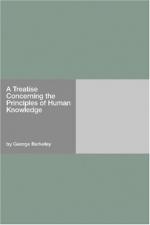16. Objection.—Answer.—But here it will be demanded, how we can know any proposition to be true of all particular triangles, except we have first seen it demonstrated of the abstract idea of A triangle which equally agrees to all? For, because a property may be demonstrated to agree to some one particular triangle, it will not thence follow that it equally belongs to any other triangle, which in all respects is not the same with it. For example, having demonstrated that the three angles of an isosceles rectangular triangle are equal to two right ones, I cannot therefore conclude this affection agrees to all other triangles which have neither a right angle nor two equal sides. It seems therefore that, to be certain this proposition is universally true, we must either make a particular demonstration for every particular triangle, which is impossible, or once for all demonstrate it of the abstract idea of A triangle, in which all the particulars do indifferently partake and by which they are all equally represented. To which I answer, that, though the idea I have in view whilst I make the demonstration be, for instance, that of an isosceles rectangular triangle whose sides are of a determinate length, I may nevertheless be certain it extends to all other rectilinear triangles, of what sort or bigness soever. And that because neither the right angle, nor the equality, nor determinate length of the sides are at all concerned in the demonstration. It is true the diagram I have in view includes all these particulars, but then there is not the least mention made of them in the proof of the proposition. It is not said the three angles are equal to two right ones, because one of them is a right angle, or because the sides comprehending it are of the same length. Which sufficiently shows that the right angle might have been oblique, and the sides unequal, and for all that the demonstration have held good. And for this reason it is that I conclude that to be true of any obliquangular or scalenon which I had demonstrated of a particular right—angled equicrural triangle, and not because I demonstrated the proposition of the abstract idea of a triangle And here it must be acknowledged that a man may consider a figure merely as triangular, without attending to the particular qualities of the angles, or relations of the sides. So far he may abstract; but this will never prove that he can frame an abstract, general, inconsistent idea of a triangle. In like manner we may consider Peter so far forth as man, or so far forth as animal without framing the fore-mentioned abstract idea, either of man or of animal, inasmuch as all that is perceived is not considered.




